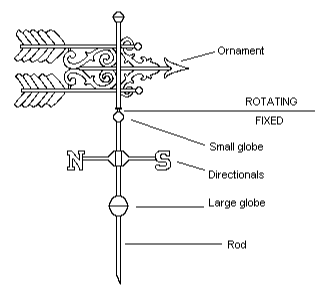In meteorology, a wind vane, also known as a weather vane or a weathercock, is an instrument that is used to indicate the direction of the wind. When applied to the highest point of a building, it is often utilized as an architectural adornment. The word vane derives from the Old English word fana, which literally translates as “flag.”
Wind vane
Generally speaking, a wind vane is an instrument that rotates in the direction that the wind is coming from. The most fundamental variant is made up of a vertical rod as its main component. There is a pointer on one end and a tailfin on the other end of this structure. In order to indicate the directions on a compass, four stationary bars are projected from this rod. Wind will cause the tailfin to spin in the opposite direction, which will, in turn, cause the pointer to rotate in the opposite direction from where it originated from.
Although more advanced scientific equipment, such as digital wind vanes and anemometers, has completely superseded these devices, wind vanes can still be used as decorative items in a home or church. If you look closely, you may discover wind vanes with ornamental figures on top — such as roosters – in place of the usual arrow signs.
Wind vane diagram

Wind vane recycled material
Wind chimes have been made of metal for a long time. It’s also possible to make a simple wind vane out of things like a pencil or stick, a straw, and cardboard.
What Are the Different Kinds of Wind Vanes?
Weathervanes are generally classified into three categories: the classic weathervane, the windsock, and the digital wind vane.
Weathervane – These are the types of weathervanes that have been in use for centuries and can be found on top of barns, cathedrals, and a variety of other structures. Because weathervanes are sometimes utilized for ornamental purposes (in addition to their utilitarian purposes), they can be found in a wide variety of shapes and styles. The conventional form has a fin in the shape of a rooster; however, a number of different fin shapes can be used in addition to the traditional style. Their designs can feature the silhouette of a well-known person, a ship, a fish, a tractor, or even an unadorned arrow. To aid the spectator in determining wind direction, four horizontal poles are typically placed beneath the fin with the letters N, S, E, and W written on them (for north, south, east, and west respectively) to aid the viewer in determining wind direction. It is simple to interpret a weathervane. The direction in which the fin is pointing will indicate the direction from which the wind is blowing.
Wind Sock – This sort of wind vane is most commonly found near runways at airports and other public places. While a windsock indicates the direction of the wind, it does not always tell whether the wind is blowing from the north, south, east, or west. The viewer, on the other hand, can determine the strength of the wind based on how much the sock has been inflated. The information is useful because, for example, a pilot must be aware of the direction and strength of the wind in order to properly adjust for the wind when landing or taking off. If you’re on a golf course, at a marina or baseball field, or anywhere else where understanding the wind direction and strength is important when participating in an activity, a windsock can be extremely handy.
Wind Vane – A digital wind vane has many of the same design characteristics as a traditional weathervane, but it is substantially more advanced in its implementation. A digital wind vane is frequently considered to be a component of a weather station, which will also measure conditions such as wind speed, temperature, humidity, barometric pressure, and, in some cases, rainfall.
A digital wind vane will either hang from the underside of a weather station sensor or will sit atop a pole or casing of some sort and rotate on a spindle to measure wind speed. At the end of the spindle, there will typically be an optical sensor that will allow a digital processor to determine the direction of the wind, which can be up to 16 places in most cases. When the reading is received, it is related to a digital display, where the direction of the wind is displayed on a circular image called a wind rose. Frequently, the wind rose will display (in the shape of arrows) the current wind direction, as well as the wind directions from the last two readings.
Conclusion
In meteorology, a wind vane is an instrument used to indicate the direction of the wind. When applied to the highest point of a building, it is often utilized as an architectural adornment. The word vane derives from the Old English word fana, which translates as “flag”. A windsock indicates the direction of the wind but does not always tell whether the wind is blowing from the north, south, east, or west. A digital wind vane has many of the same design characteristics as a traditional weathervane but is substantially more advanced in its implementation.
 Profile
Profile Settings
Settings Refer your friends
Refer your friends Sign out
Sign out






